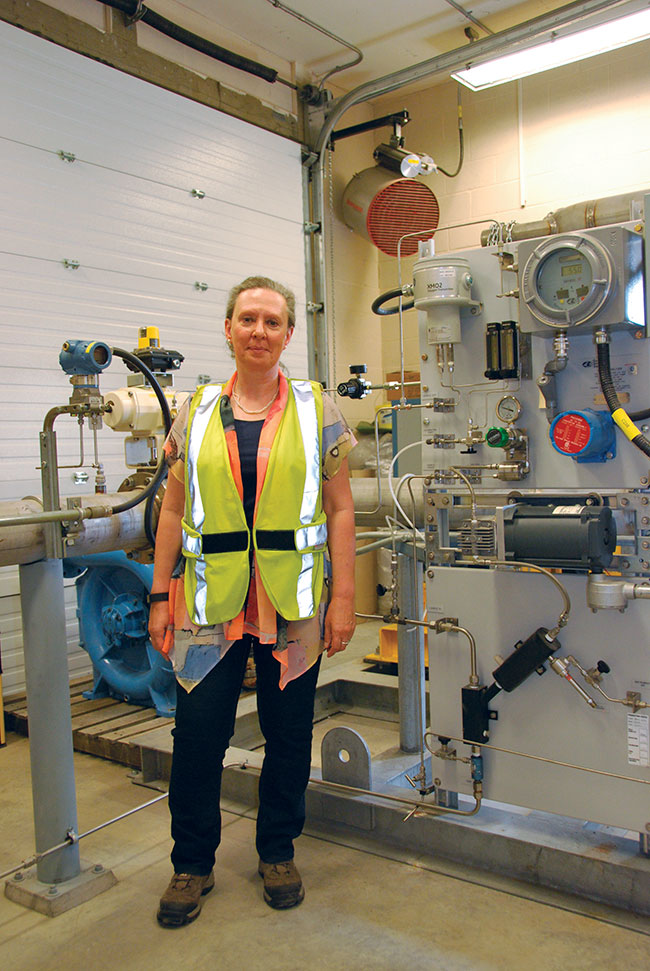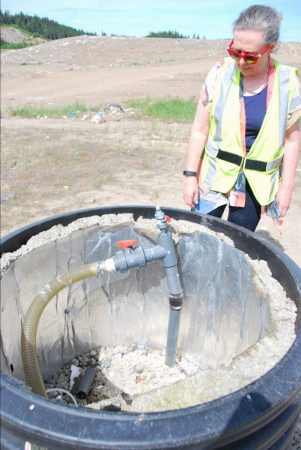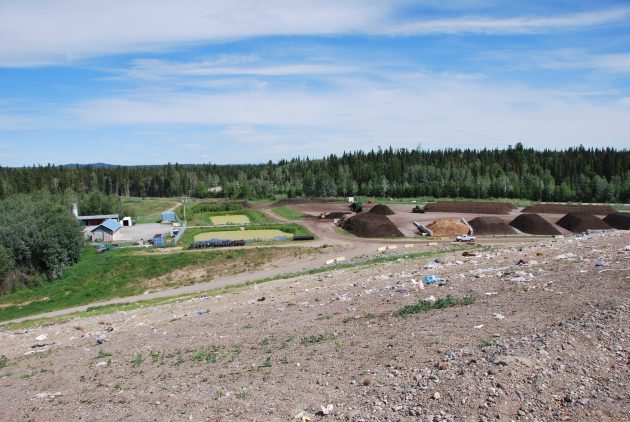
Landing RNG: Prince George landfill harnesses the power of household waste
November 4, 2019
By
Maria Church
 Petra Wildauer, general manager of environmental services for the Foothills Boulevard Regional Landfill, inside the abstraction plant where biogas is collected and combusted in an enclosed flare.
Petra Wildauer, general manager of environmental services for the Foothills Boulevard Regional Landfill, inside the abstraction plant where biogas is collected and combusted in an enclosed flare. A regional landfill just outside of Prince George, B.C., that sees around 73,000 tonnes of household and construction waste in a year, is finding new ways to harness the power of trash.
The Regional District of Fraser-Fort George owns and operates the Foothills Boulevard Regional Landfill and is partnering with provincial utility FortisBC to produce Renewable Natural Gas (RNG) – a purified biomethane – for the province’s gas grid. The project will have the capacity to produce up to 100,000 gigajoules of RNG annually, enough to heat up to 1,100 homes on 100 per cent RNG.
Canadian Biomass visited the landfill in June to learn how the site captures biogas generated from decomposing garbage.
Petra Wildauer is the general manager of environmental services for the Foothills Boulevard Regional Landfill. She says the landfill has been collecting biogas since 2002 when the system was installed voluntarily in order to reduce the environmental impact and support the long-term goal of attracting beneficial use alternatives.
“The regional board, from the time of approving the installation of the landfill gas collection system, has always kept the utilization of the landfill gas in mind,” Wildauer says.
The landfill collects biogas from 16 vertical wells staggered throughout an area of the landfill that underwent final closure, meaning it’s no longer actively used for landfilling waste. Final closure is a regulatory requirement of all landfills in British Columbia to create a closed-lid system that encapsulates the garbage and supports emission reduction.
Within the landfill, vertical gas wells are uniformly installed to different depths, determined by the height of garbage and estimated availability of landfill gas. A blower pulls the gas from the wells to the collection header.
“Landfill gas is created from the decomposing waste. The gas itself is roughly half methane and half carbon dioxide. The rate of collection from the individual wells is monitored and continuously adjusted to ensure the best quality and quantity of gas being produced,” Wildauer explains.
The collection system vacuum pulls biogas through an extensive high-density polyethylene piping system to the abstraction plant, where the biogas is combusted in an enclosed flare up to 1000 C with a 98 per cent methane-destruction efficiency
Treating the gas
While the majority of the gas produced by decomposing garbage is biomethane, other minor components are produced as well, such as sulphur, which must be removed before the biogas can enter the natural gas grid. The Foothills Boulevard Regional Landfill restricts what type of waste it accepts in order to minimize those additional undesirable components in the biogas.

Petra stands behind a biogas vertical well, one of 16 staggered throughout an area of the landfill that underwent final closure.
Another unwanted component in biogas is condensate – the liquid formed when landfill gas cools down. It is removed and collected in condensate traps located within low points within the collections system.
The entire biogas collection and burn-off system was a turn-key project built by JZHC (John Zink Hamworthy Combustion) in 2002. The collection system infrastructure and computer software used provides continuous information on landfill gas quality and quantity.
There are eight vertical wells and three horizontal wells in other areas of the landfill. This network of gas wells provides a total biogas flow of 256 cubic feet per minute or 435 cubic metres per hour.
“Approximately 250 cubic feet is the standard to run any engine, so we are at that threshold of making it work for any utilization,” Wildauer says.
Enter FortisBC
FortisBC has five active RNG suppliers across the province, from Delta to Salmon Arm. The Prince George site would be their most northern.
The utility first entered the RNG game nearly a decade ago when it began accepting biomethane from Fraser Valley Biogas in Abbotsford, B.C., in 2010. Fraser Valley Biogas was the first agricultural biogas operation in the province, and the first biogas plant in Canada to produce and inject RNG into a gas pipeline.
Scott Gramm, manager of Renewable Natural Gas for FortisBC, was there from the beginning, working with Fraser Valley Biogas and the subsequent four suppliers in the province.
“We want to do what’s right for our customers and we also want to align with government policy – those are the two primary reasons for us to work with RNG,” Gramm says.
Two other landfills supply biogas to FortisBC: Salmon Arm Landfill in Salmon Arm, B.C., and Glenmore Landfill in Kelowna, B.C. FortisBC’s role with the landfill suppliers is to install and operate upgrading equipment on site. That equipment purifies the biomethane from the landfill, bringing it up to spec for injection into the natural gas pipeline.
“The way you can think of it conceptually is like a water filter. You have water that’s kind of murky and dirty, you put it in a filter and it comes out clear. That’s essentially the step we’re doing for this biogas at landfills,” Gramm says. “When you remove the gas that isn’t useful, you’re essentially increasing the energy content per volume.”
The upgrading equipment first removes contaminants such as hydrogen sulphides and volatile organic compounds from the breakdown of plastics and soaps, leaving carbon dioxide, nitrogen, oxygen and methane. A second, two-step process removes nitrogen, oxygen and carbon dioxide, leaving only methane for injection into the FortisBC pipeline.
“For both Salmon Arm and Glenmore, we use pressure swing adsorption, leaving a purified gas. We odourize it with something called a mercaptan, which is really just for safety so that if there is a leak it’s obvious to detect,” Gramm says.
The bulk of the project’s $8-million capital investment is coming from FortisBC. The upgrading plants are designed to operate unmanned.
Connections

The landfill just north of Prince George, B.C., has been collecting biogas since 2002 when the system was installed voluntarily. A new partnership with FortisBC will see the biogas purified and added to the province’s gas grid as renewable natural gas.
“On our side, we will be making sure our equipment matches the needs of FortisBC for transferring our gas,” Wildauer says.
Requirements from the landfill include new insulated piping to the FortisBC facility, emergency shutoff valves, as well as upgrades to measurement devices to determine how much gas is flowing into FortisBC’s equipment.
“You always need redundancy for landfill gas. Our flare will be replaced eventually by a smaller flare that can handle less volume. Should either plant go down we can move back to flaring to reduce our emissions footprint,” Wildauer says.
If approved, construction for the project is set for spring next year, with the first RNG anticipated to enter the grid in late 2020.
Targeting 15 per cent
In late 2018, the B.C. government released a policy document called CleanBC that outlines renewable energy targets for 2030. One target is a 15 per cent renewable gas standard for B.C.’s natural gas system.
With the Foothills Boulevard Regional Landfill online next year, FortisBC will be around one per cent RNG. “If we want to get to the 15 per cent, we’re going to have to consider different sources of gas,” Gramm says. “That includes potentially wood waste-derived renewable natural gas, and we’re considering things like hydrogen in the long run. These are all possibilities.”
FortisBC is continually on the hunt for new RNG projects with low-carbon intensity, for $30 a gigajoule or less, ideally within B.C., Gramm says. “If you have a project that fits, then reach out to us. We’re willing to talk to you.”
FortisBC RNG timeline
- 2010: RNG was first accepted into FortisBC’s system from Fraser Valley Biogas in Abbotsford, B.C.
- 2011: FortisBC established its RNG customer program as a two-year pilot
- 2012: Salmon Arm Landfill in Salmon Arm, B.C., came online
- 2013: permanent RNG program was established
- 2015: Glenmore Landfill in Kelowna, B.C., came online
- 2015 Seabreeze Farms in Delta, B.C., came online
- 2016: regulatory approval for revised provincial RNG rate
- 2017: BC Climate Policy now allows up to five per cent RNG in natural gas distribution system
- 2018: Surrey Biofuel Facility in Surrey, B.C., opens
This article is part of Biofuels Week 2023. To read more articles on biofuels, click here.
Print this page